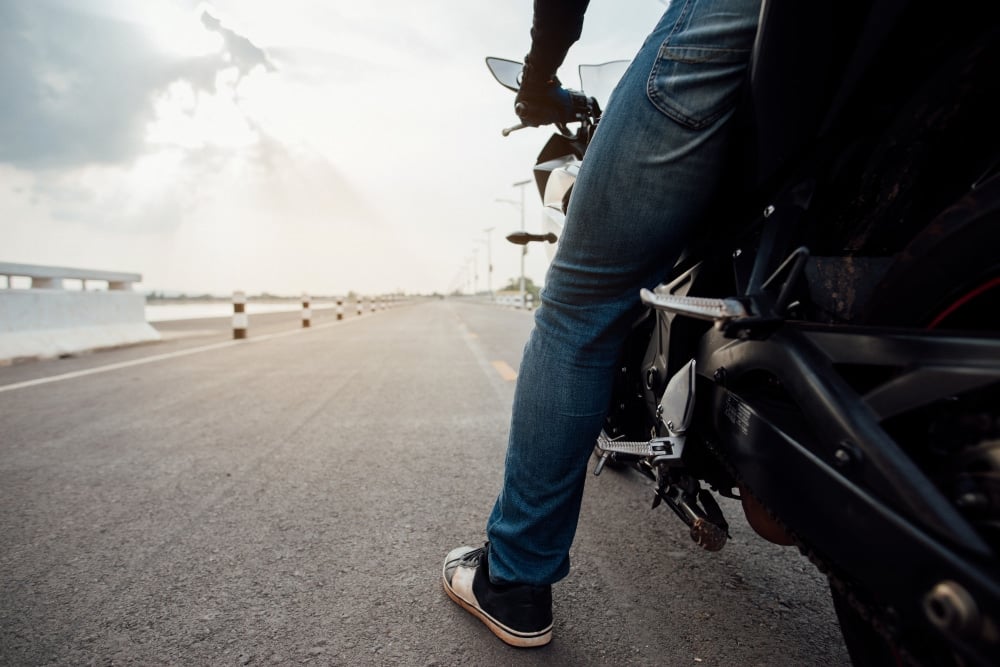If you had your own two wheels right before a little one came into your life, it might have been a family decision to let it go. Often the sports car and motorcycles are upgraded (yes, I said upgraded) to an expedition or minivan.

Dads with Motorcycles
These are sacrifices we all don’t mind making in the long run. Yes, it hurts to let go, but knowing you can travel safer with your whole family is the win.
However, some opt to store their motorcycles as a small getaway option between the hustle of life’s demands and being a dad. This idea I salute; Yes, I encourage. Or, perhaps the kids are older, the household’s cash flow has increased, and you find yourself envisioning a relaxed motorcycle drive with your significant other. Go for it!
This article does not take a side as to whether or not a parent should own a motorcycle. Instead, if you do, we want to provide you with a couple of safety measures you can keep in mind.
Because ultimately, we all want to ensure every ride ends with you coming back to your warm and cozy home. We reached out to an experienced motorcycle accident attorney, John M. O’Brien, who knows, all too well, what can happen on the roads we all share.
First off, if you have never driven a motorcycle, you should be aware that you need to get a motorcycle license before heading out on any open road. Check with your local DMV to see what is required to obtain one.
An experienced motorcycle accident lawyer can tell you how lots of crashes occur due to a lack of skill on the two-wheeler. This does not mean you should give up the thrill of riding, but it is essential to be responsible and take the necessary steps to ensure your safety and the safety of others on the road.
A driving skills test will often be included in the process wherein you will have to demonstrate your ability to handle your bike in front of a DMV representative. Parts of the test could require you to slowly weave around cones successfully in the parking lot without knocking them down.
In addition, it may require you to turn your bike in a 180-degree circle, mimicking a U-turn, while ensuring your front wheel stays in the outline designated zone on the pavement.
Such tests can cause the most seasoned motorcyclist to get a little nervous, and some often will take the time to recreate the course at home.
California Highway Patrol (CHP) offers motorcyclist training courses that will aid you in successfully obtaining your class M license. Mr. O’Brien had taken this course with his son and shared his thoughts on the matter: “I recommend going through the CHP’s approved course as a precursor to getting your motorcycle license.
It’s a 4-day intensive course that emphasizes safe riding and requires that you have a basic skill level for many of the dangerous conditions you’re likely to encounter on your bike while riding on the streets. My son and I did it together, and it was a great bonding experience!”
Not only will the course be taught in a classroom setting, but motorcycles are provided on a controlled course to put into practice the knowledge you obtained in the classroom.
The safety tips provided in the class will expedite your abilities as a rider. You will notice the difference between self-taught riders and those who adhere to practical safety standards taught in the class.
Second, get the best and most insurance you can afford. One can often be tempted to opt for the state’s minimum insurance requirement to save money. However, even a minor accident can often result in serious injury to a rider.
Sadly, if you are ever injured and the at-fault party has minimal coverage, this can negatively affect you and your family. Consider your insurance as being protection for yourself and your family. Always hope for the best but prepare for the worse.
Lastly, here is a list of some well-known safety measures that are the best to stick to:
- Know the weather: Always remember to check the weather before you head out. Keep your bike well maintained, especially when you are taking it out at the start of the season.
- Wear the proper DOT-approved safety helmet: These are helmets that are designed and tested to protect your head in the most common types of crash impacts.
- Wear proper protective clothing and shoes: Long-sleeves and jeans can be layered with quality riding gear giving you extra protection between you and the pavement if needed.
- Never assume other motorists see you: Ultimately, it is best to be proactive by riding with caution. Studies have shown that motorists have a tendency not to look for motorcyclists on the road.
Considering these tips before heading out to ride, we hope they will help you keep safe during your well-earned getaway.
Realistically, we know that the joys of fatherhood will ensure you take the least amount of risk while out and ensure you are home refreshed and ready to take on what daily life throws at you!

